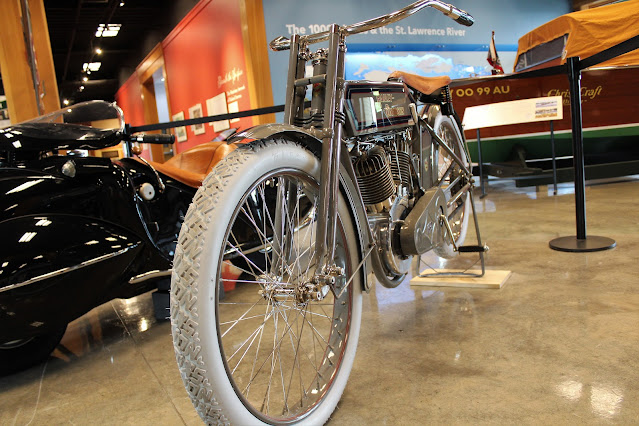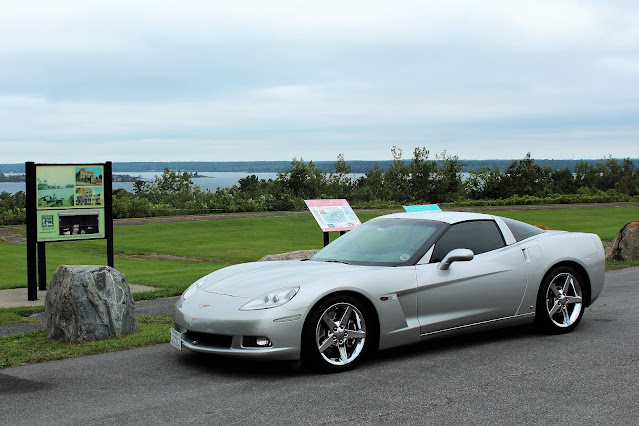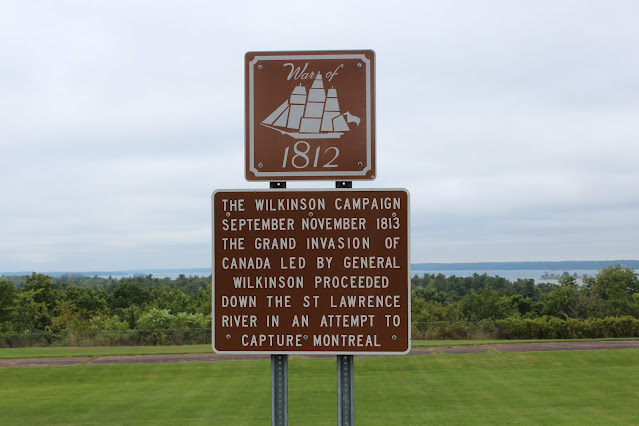As I had to go to New York State to pick up a parcel at the UPS Store in Ogdensburg (as the supplier of my barbecue parts no longer will ship them to Canada), I thought since I was going to the trouble of crossing the border and paying the bridge tolls, I would see what else I could do. I picked up a brochure about the Antique Boat Museum in Clayton, an hour west of Ogdensburg, and thought I would exercise the Corvette in that direction.
It was the day after Labour Day and traffic was very light on a Tuesday morning as I left Ogdensburg, southbound on Hwy 12. I eventually came to a parking area near Chippewa Bay that had some plaques, so I pulled off to take a look. In addition to one about the Scottish settlers who cleared the area in the early 1800s, there is a sign noting that it was from this area that the invasion of Canada, with the intent to capture Montreal, took place with an army under General James Wilkinson in 1813. The American force was defeated by a smaller British force in the Battle of Crysler's Farm, near present-day Morrisburg, Ontario. Wilkinson tried again the following year but was unsuccessful again and was relieved of command. Having twice served earlier as Senior Officer of the United States Army and as Governor of the Louisiana Territory, his resume was impressive for someone considered to be a scoundrel. He eventually died in Mexico City in 1825, where he was US Envoy, and it was later discovered that he had been in the pay of the Spanish for years. Theodore Roosevelt said of Wilkinson: "In all our history there has been no more despicable character." Nothing on the sign about this, alas.
Just visible from my parking spot was Dark Island, the location of the Singer Castle. Built in 1905 by Frederick Bourne, CEO of the huge multinational Singer Manufacturing Company, it has 28 bedrooms. Inspired by a castle in Woodstock, England, described in a Sir Walter Scott novel, the house, expanded by Bourne's daughter in 1928, includes secret passages. Smaller than the more famous Boldt Castle further down the river, it was known for many years as "The Towers" or "Dark Island Castle" and has had a checkered past after leaving the hands of the Bourne family in the 1960s. It is open to public tours presently and can be used for weddings and even overnight stays. More info here.
Passing the exit for Alexandria Bay, another popular tourist spot, I soon came to Clayton, a thriving village in the township of the same name. The village has a population of around 2,000 and is an active summer resort. It was easy to find the location of the Antique Boat Museum as there was good signage but I was also surprised by the size of the establishment. Time to park the car and get museum-ing! check out this introduction:
For some reason it took a while to get my ticket as the volunteer running the admission area was giving some pretty lengthy explanations to the two couples ahead of me, but this gave me a few moments to look around. There were a pair of interesting motorcycles on display in the lobby area and I could see the first of the antique boats in the background.
 |
| 1913 Harley-Davidson Model 9-E |
This rare motorcycle marks the first year that Harley-Davidson introduced the "big twin" engine, and the "E" designation indicates that it has a clutch, a useful thing for a chain-driven motorcycle, albeit one with no transmission, something H-Ds were only to get three years later. Claimed top speed of this 300 lb. motorcycle was 55 mph and it cost $285.
 |
| 1930 Henderson KJ Streamline |
I love the wacky Art Deco design of this motorcycle, which was capable of 100 mph with its 40 hp 1200 cc inline four cylinder engine. A metalworker for Oldsmobile, Orley Ray Courtney believed in the advantages of an enclosed body for a motorcycle to enhance comfort and luxury and in 1935 he rebodied a standard Henderson KJ, a one-off project of beautiful workmanship and great style. Fairings were pretty much unknown for motorcycles of that time except for specialized racing machines. Courtney's motorcycle, impractical and hard to ride, remained unique but a wonderful example of the trend of the time to make everything in Streamline Moderne look fast, from locomotives to toasters.
After getting my admission ticket, I passed a very interesting display of artwork devote to marine wrecks of Lake Ontario, with paintings showing the ships in their original state and then as being found by marine archaeologists as relics on the lakebed. The most interesting of these was perhaps the HMS Ontario, a British 22-gun brig-sloop that sank in a storm in 1780, five months after she was launched, and whose essentially intact wreckage was found only in 2008, using side-looking sonar at a depth of 150 m.
After these sad stories it was nice to come into the first exhibition area of the museum, which was all about tourism in the Thousand Islands Region. Millionaires had begun to buy up islands for summer residences and in 1872 railway carriage tycoon George Pullman invited then-President Ulysses S. Grant to visit Pullman Island, along with some notable Civil War figures including General Philip Sheridan and Admiral David Porter, to stay over for a week. Thus the little-known Thousand Islands was a region that reached the national consciousness and a boom in tourism began. This was a Very Big Deal, with train service from New York City taking only eight hours to reach Clayton, and offering many forms of diversion, from fishing to all kinds of boating. Visitors ranged over all social classes, from some of the wealthiest industrialists and socialites to those of more modest means.
Of course, this meant all kinds of local employment, from dining and guest house establishments to guiding fishermen to boat building. A lovely example of a local watercraft, the St. Lawrence skiff, is on display in this room. The skiff Katherine was built in 1885 by a shop in Clayton. The skiff is narrow and light enough to row easily, although heavy enough to deal with the choppy swells that can occur on the St. Lawrence. It can be used with a simple sail with favourable conditions. Skiffs are multi-purpose vessels but Katherine was equipped primarily for fishing, with clips inside to hold rods. The boat has an appealing shape and beautiful workmanship.
The Antique Boat Museum is the largest in North America and the campus, with multiple buildings, covers 4.5 acres, and has 29,000 square feet of exhibition space. Leaving the main building, I entered a stone building, dating to 1880 and the oldest on site, to look at the restoration shop where work on an impressive speedboat is being undertaken, along with other projects.
Footloose and Fancy Free is a spectacular three-cockpit runabout that was commissioned by the Bourne family (yes, the Singer-connected people from Dark Island). Built in 1937 by the Fitzgerald & Lee yard in Alexandria Bay, it was powered by a 300 hp Scripps V-12 engine, which was capable of pushing the 28 foot long speedster to 50 mph. Designed by the famous John Hacker, Footloose and Fancy Free is a unique custom boat that shows what a specialist builder can produce. As noted in the video, the boat went through numerous engine changes in its lifetime but will now be equipped with the correct Scripps 302 V-12 engine. Rated at 316 hp, these rare motors weigh around 1,800 lbs.
Just outside the door to the stone building is a small runabout in which visitors can have their photos taken. What was interesting is that although it appears to be a wooden boat, it is actually fiberglass yet finished to have that timeless appeal of fine varnished wood!
This attractive structure was dedicated, as the name indicates, to small boats, including canoes, skiffs and launches. These small watercraft were really quite beautiful, with their warm wood tones. There were two big posters as you entered the building featuring canoes made in Peterborough, Ontario (home of the Canadian Canoe Museum!).
I was particularly taken with the decked canoes. of which I had never heard before, which were marketed as "poor man's yachts" in that that they were elegantly outfitted with sails. The example on display, a 14 foot boat named "Pixie," was built by the Bowdish Manufacturing Company in Skaneateles, New York, c. 1888-1899, when the type was in its heyday. Very few Bowdish boats, clearly high-quality items, have survived.
The next interesting boat on display was a folding canoe, which allowed for easy dismantling and transportation. There have been folding kayaks on the market for many years (Klepper in Germany beginning commercial production in 1906) and a number of companies also make folding canoes. The example on display was actually invented by flight simulator and underwater technology pioneer Edwin Link (1904-1981) and known as the Linkanoe. Link wanted a canoe to use at his cottage in Quebec, to which he flew in his Grumman Widgeon amphibian airplane, but none on the market would fit in the Widgeon so he came up with this model. It is covered with a waterproof canvas skin held on with shock cords over a wooden frame, holding together ten shaped sections made of resin-impregnated cloth. The Linkanoe was built for only three years at Link's factory in Ganonoque, Ontario, with production totaling around 4000. Two examples were on display, one assembled, the other demonstrating its portability. The Linkanoe could be packed into two canvas bags--with the paddles used as handles!
The museum offers the opportunity to go rowing in a St. Lawrence skiff and several of them were stored in the building as it was off-season. The skiff was an adaptable design and with the availability of small engines it was enlarged to take small power units, although the appearance remained pretty much the same. These powered versions were known as "skiff putts." On display was "Elektra," an electric variant, which was based on a 1911 skiff at the museum.
Nearby was a boat with quite a past. Originally built as a steam launch by the Bowdish shop in 1887, "Fawn" had her engine replaced with a gasoline motor in 1908, a common practice given the complexity of operating steam. She languished in the woods for 25 years until rescued by a couple, who spent five years restoring the derelict boat, even locating its Buffalo gasoline engine. The boat has won numerous awards.
 |
| The restored "Fawn" |
Another striking boat, very elegant yet simple, was the Adirondack Guideboat. Developed in the mountain region for fishing and hunting, it featured ribs made from tamarack knees (the L-shaped pieces formed where the trunk becomes roots), and was generally planked with white pine that had overlapping edges for a smooth hull. The planks are fastened with thousands of tiny screws and tacks. The example in the museum dates between 1907 and 1926 and was built in the shop of George Washington Smith in the small town of Long Lake, NY.
.png)






























No comments:
Post a Comment